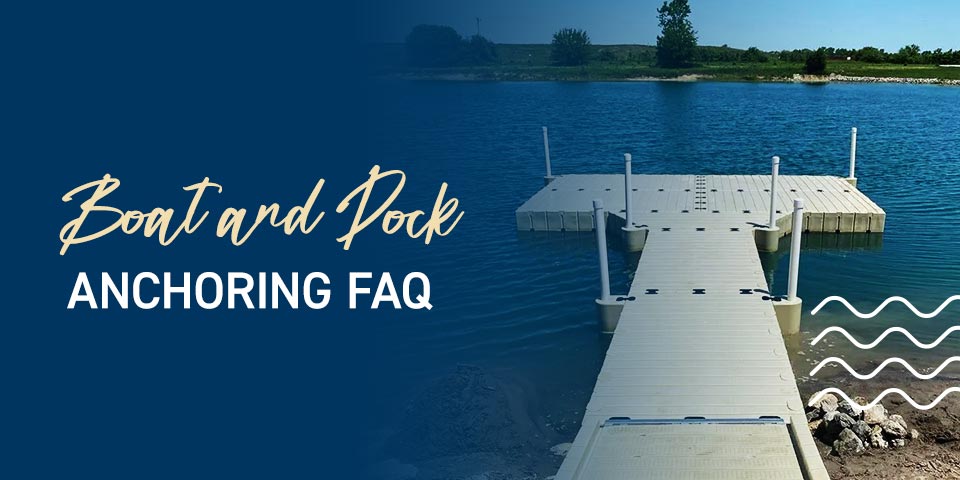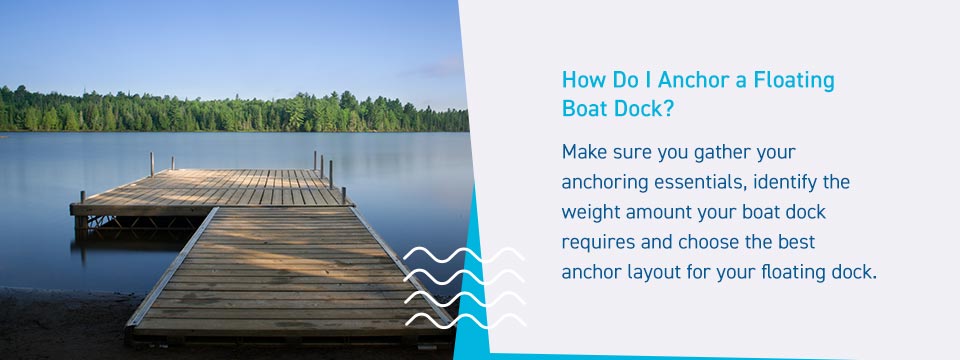Filters
Boat and Dock Anchoring FAQ
Finding and installing a boat dock anchor can be a simple process once you understand the types of anchors and the installation process. Here are some boat dock anchoring FAQs to answer your many questions about best practices and tips for anchoring.
What Types of Boat Dock Anchors Are There?
Various boat dock anchors make it easier to attach your boat dock to different water levels. Whether you plan to add a boat dock to a shallow area or deep lake water, you’ll want to find a suitable anchor that fits your needs.
1. Cable Anchoring
Cable anchoring is one of the most common and affordable methods. A cable anchor attaches to the weights or the shore in cases of shallow water but is most often used in deep water applications. Most boat enthusiasts enjoy cable anchors for their flexible mobility. By moving away or toward the shoreline, cable anchors can adjust to the weather, season or current water levels.
Cable anchors are also an excellent choice during the following:
- Water fluctuations: Changing water levels or fluctuating weather conditions affect the water level.
- Heavy winds: Heavy wind could affect the water’s conditions or the anchor’s ability to stay put.
- Wave loads: If the water on the shoreline, ocean or lake experiences large wave loads, it may affect the durability of the dock.
- Multiple cable applications: You can use several cables to attach the anchor to the shore and improve safety and durability.
2. Pole and Sleeve Anchoring
Pole and sleeve anchors can assist in windy areas that may experience high waves. With durable vertical sleeves often made of galvanized steel connected to the dock, pole and sleeve anchors insert the poles through the sleeves and attach them to the water bed. Many use a cable or winch system to make removal easier and keep the dock in place during high winds or extreme waves.
Using a pole and sleeve anchor is beneficial for areas that may receive winds and waves but have a stable water bed that isn’t too rocky. With a durable sleeve connection and steel poles, the boat dock anchor also increases flexibility and can move with changing water levels or weather seasons.
3. Pile Anchoring
Pile anchors can provide stability to boat docks carrying many people, heavy supplies or boating objects. Pile anchors use pile slides built into rollers that help secure the anchor system to the boat dock. The piles are often made from steel, concrete, fiberglass or wood driven into the surface of the water bed.
The one downside of pile anchors is that you cannot relocate them during colder seasons, so you’ll want to ensure the pile anchors are correctly mounted before winter rolls around. However, pile anchors are an excellent addition for docks that need stability during changing water levels or windy weather.
4. Stiff Arm Anchoring
Stiff arm anchors allow boaters to transport heavy loads between the shore and the dock or hold many people. These anchors also use a winch or cable system and reinforced arms to attach the floating dock to the shoreline. Often, the cables are placed diagonally between the reinforced arms, while the attached gangway acts as a leg to the system.
Many boaters appreciate how affordable a stiff arm anchoring system can be. They are most suited for near-shore locations and areas that don’t experience fluctuations in water levels.
What Boat Dock Anchor Should I Buy?
The kind of boat dock anchor you should buy depends on different factors. Assess the local climate and water situation. Some other considerations include the following:
- Water depth
- The distance you require between the floating dock and the shoreline
- Fluctuating water levels
- Wave and wind force
- Dock requirements or anchor requirements due to the dock size
- Local laws and regulations
How Do I Anchor a Floating Boat Dock?
Anchoring a floating dock requires specific steps during the installation process. Make sure you gather your anchoring essentials, identify the weight amount your boat dock requires and choose the best anchor layout for your floating dock.
Anchor Essentials
Gathering your essential supplies before you begin the installation can ensure a fast and easy process. Some supplies to find include:
- Anchor: Your anchor helps stabilize the floating dock and keep it safe during extreme weather or windy days. Depending on the shape or dock weight, some docks may require a specific kind of anchor.
- Chains: A galvanized chain helps connect the anchors to the boat dock and support the entire system.
- Eyebolts: Eyebolts are fasteners that attach to the head of the quick chain link and form a ring. The bolts help support the main structure.
- Chain quick link: A quick chain link connects the chain and rebar or the chain and eyebolts.
Weight Amount
Ensure you don’t add more weight than necessary, but have enough weight to secure the floating dock. The anchors will remain in the water after you’ve installed them, so consider their weight and placement carefully before the process. Your floating dock may also require a certain amount of weight at the corners or an anchoring system every few feet.
Anchor Layout
The anchor system’s layout may affect the floating dock’s stability. There are three factors to consider when perfecting this layout:
- Crisscross layout: Some choose to place their anchors and chains on both sides of the platform, crossing the chains through each rebar or attaching them to the opposite corner’s eyebolt. The corners of the anchor system will cross each other and may work to make the system more durable.
- Chain length: Some boaters leave a few inches of extra material to allow for slack during the anchoring process. A shorter chain length may cause tension and stress on the chain, resulting in a floating dock that sits a little too low in the water. You may even prefer to adjust the chain length as the water levels in your area change.
- Chain tension cords: Tension cords may be best suited for areas with fluctuating water levels. An anchor chain tension cord provides some slack to your chain and includes a bit of tension to improve stability. The tension cords reduce stress on the anchoring system and boating dock by expanding or decreasing with changing water levels.
The Installation Process
Start by placing the anchor or anchors on a slab of wood to avoid damaging the floating dock material. Place a few anchors you’ll use together and run a chain through the rebar or eyebolts. Ensure you avoid cutting the chain or causing too much tension with a short chain.
Lift the wooden slab to slide the anchors into the water. Make sure the anchors drop into the water gently to avoid too much stress on the chains or the dock system.
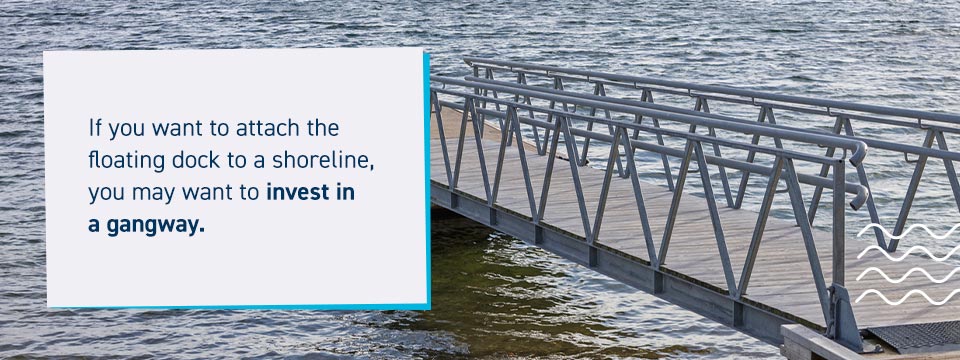
How Do I Anchor a Floating Dock to the Shore?
If you want to attach the floating dock to a shoreline, you may want to invest in a gangway. The gangway can help connect the floating dock and shore through an extended platform that helps span the distance between the land and the port. Some gangways even come with handrails to improve dock safety.
There are many different situations where a gangway may be appropriate. Some conditions include the following:
- Shallow water: Shallow water near the shore means you may want to place the dock further away from the land.
- Dock accessibility: You and your passengers may require a more accessible dock from specific points on land.
- Dock transitions: A gangway creates a transition between the dock and the shoreline, making it easy and comfortable for guests to access the boats.
Consider different gangway materials. Aluminum gangways offer resistance against corrosion and can be lighter and easy to care for. Polyethylene gangways, on the other hand, use durable and low-maintenance materials.
Where Can I Anchor a Boat?
Before anchoring your boat, study available charts or information about the water depths. You’ll also want to be familiar with the kind of bottom you’ll be anchoring a boat into to prevent dragging. Ensure the bottom of the water is clear of obstructions like rocks, seagrass or coral and research local pilot or guidebooks for photographs on anchor types and safe areas to anchor. Some guidebooks also contain helpful abbreviations, pictures and information to assist you in identifying the bottom type, whether it’s kelp, rock or mud.
You can also find out where to anchor a boat by watching where other boats currently anchor. Ensure you have a safe space for the swinging room so you don’t hit any other boats. If a place looks crowded, it may be best to consider a different area. Typically, boaters will practice good boating manners by anchoring far away from other vessels to remain safe during tide changes, wind and currents.
How Do I Properly Anchor a Boat?
Anchoring a boat requires careful consideration and reliable knowledge about the area. Once you’ve gathered information from the locals and found a good spot to anchor, follow these steps:
Step One: Choose a Spot
Look at your surroundings and find a safe space for your boat that is not too deep or too shallow. This will make anchoring easier, especially if you avoid wildlife habitats, rock formations or coral reefs. If the winds are exceptionally high during the day, try to find a spot on the opposite side of a small island or dirt formation to break up the wind’s movement. While popular areas may mean a good anchoring spot, try to make space for other boaters by keeping a safe distance from them.
Step Two: Wear Protective Gear
Once you’ve found a good spot, put on a life jacket or flotation device. In some cases, heavy winds, waves or currents could cause unsafe conditions or lead to injury. You’ll want all your passengers to be prepared with life jackets if anchoring the boat may take a few tries due to the conditions.
Step Three: Reduce and Reverse
Once you’ve chosen a spot and prepared with protective gear, ease up on your boat’s throttle and start reversing the engine. This will help you reduce your speed and come to a standstill.
Step Four: Tie the Line
Once at a near standstill, secure the anchor line to the cleat located at the bow. You’ll want to double-check that the line is strong enough to leave it overnight. An anchor line with a chain may also strengthen the anchor system and remain durable for several years.
Step Five: Lower the Anchor
After tying the line to the cleat, you can slowly lower your anchor. Make sure you drop it slowly rather than all at once, and avoid leaning over the boat’s edge. If the anchor happens to slip or fall quickly, you could also fall into the water. Keep one hand on the railing, or help a few people feed the line until it hits bottom.
Step Six: Test the Anchor
When the anchor hits the water bottom, pull on it a bit to test the stability of the anchor and line. After testing the strength, you can release the rode, also known as the anchor line.
Step Seven: Let out the Scope
Next, you’ll want to calculate your scope. The scope is the amount of rode or chains you will release from the attached anchor. Different boats or weather circumstances may require an extra length, so you’ll want to familiarize yourself with the area and your boat’s requirements before letting out the scope.
Step Eight: Test the Drag
After letting out the rode, check the line for any dragging. Some boats come equipped with technology that sends you an alarm when your anchor is drifting.
Step Nine: Find a Landmark
Look for a familiar landmark so you can keep track of your boat’s dragging or movement during the day. Some milestones may include a mountain, a nearby shore or other boats on the water.
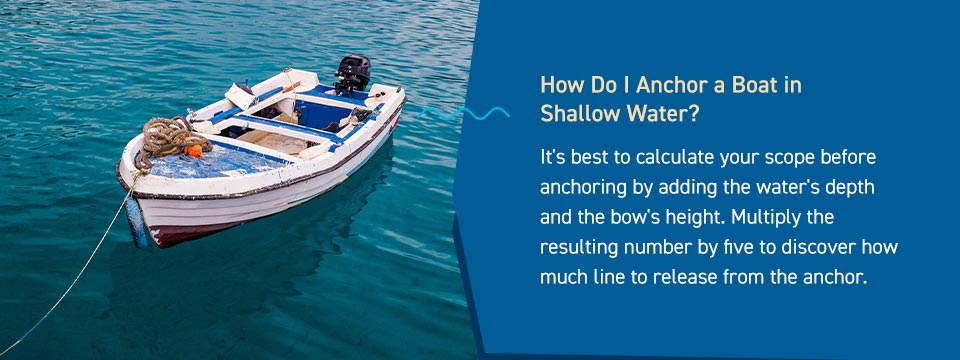
How Do I Anchor a Boat in Shallow Water?
Shallow water requires the right amount of scope where you plan to anchor. It’s best to calculate your scope before anchoring by adding the water’s depth and the bow’s height. Multiply the resulting number by five to discover how much line to release from the anchor.
Once you have this number, gently lower the anchor into the water and make your way back to the wheel. Move the boat back until the line entirely moves out and becomes taut. The current or the wind will work in your favor, and once the anchor sets, you can put tension on it and ensure the system is stable.
How Do I Anchor a Boat in a Lake?
Anchoring a boat in a lake is similar to anchoring in any other body of water. There are a few steps to follow so the anchor line is stable and the system does not drag throughout the day:
- Position the boat: Find a good anchoring spot and face the boat against the current. Bring the boat to a near-stop and prepare to drop the anchor.
- Drop the anchor: Slowly drop it into the water and secure it to the boat. Make sure you ease the line into the lake rather than drop it all at once.
- Back up the boat: Back the boat along with the current and allow the line to extend and become taught.
- Check for stability: Ensure the line is not dragging and the anchor is stable and secure.
How Much Value Does a Boat Dock Add to a Home?
A well-maintained boat dock made of reliable materials can add significant value to your home or property. One of the main benefits of a boat dock is that it will increase your home’s value by several thousand dollars. Your home can be highly sought after in the marketplace and sell much faster once it’s time to find a new owner.
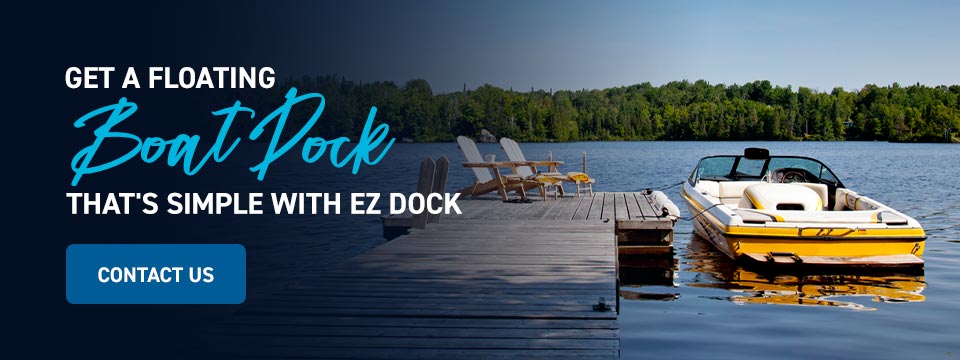
Get a Floating Boat Dock That’s Simple With EZ Dock
EZ Dock provides boat enthusiasts with secure dock sections made of polyethylene. If you want reliable and slip-resistant docking material, we offer low-maintenance solutions for any body of water. Whether you need a dock for shallow, deep or lake water, EZ Dock gives you a docking system that adapts to changing water levels and keeps its strength throughout the years. Contact us today to speak to a representative, or call us at 800-654-8168.

